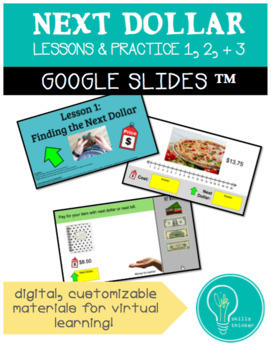Next Dollar Up Lessons & Practice (special education life skills, math)
- Google Drive™ folder

What educators are saying
Description
Teach students the basics of using the next dollar up and next bill up strategy. These SIX Google Slides presentations are versatile, good to use for both teaching during a live class or providing to students to work on independently on their own time. In my own remote classroom, I tend to use lessons for live lessons and practice for group work or homework!
WHAT'S INCLUDED:
1) LESSON 1: Finding the Next Dollar (27 slides): Learn how to find the next dollar of a price by isolating the dollars and going to the next number.
2) Practice 1 (15 slides / 10 problems): Practice finding the next dollar of given prices.
3) LESSON 2: Using the Next Dollar Strategy (25 slides): Learn how to actually use the next dollar strategy by finding the next dollar of an item and also counting out the bills to pay. The goal is for students to learn to apply the next dollar strategy automatically to purchasing scenarios, without prompting from staff.
4) Practice 2 (26 slides / 10 problems): Practice finding the next dollar of given prices and counting out the money to pay.
5) LESSON 3: Using the Next Bill Strategy (28 slides): Learn how to find the next biggest bill to pay with, if you can’t make the exact next dollar with the money in your wallet.
6) Practice 3 (21 slides / 15 problems): Practice using the next bill to pay for items. Then, practice with mixed problems, where the student has to decide whether to use next dollar or next bill to pay for items.
THINGS TO TAKE NOTE OF:
* There are detailed teacher notes in the speaker notes section underneath the first slide. Please read them before using these slides!
* All questions in these lessons are limited to money amounts under $20. To make these lessons more challenging, simply change the numbers on the slides to larger numbers.
* You can very easily increase (or decrease, depending on your students) the number of practice problems in the set. You can also duplicate the entire presentation to create additional practice sets. The more repeated practice, the better! :)
* You are more than welcome to contact me with any questions on how to customize or differentiate these materials for your students. I would love to be of more help!
RELATED MATERIALS:
• Banking Unit (Printable Packets + Quizzes)
• Counting Money Lessons & Practice 1-3 (Google Slides)
• Counting Money Lessons & Practice 4-5 (Google Slides)
• Counting Money Unit 1 Packet (Printable Packet)
• Counting Money Unit 2 Packet (Printable Packet)
TERMS OF USE:
• All rights reserved by © 2020 LIFE SKILLS THINKER.
• This material is only to be used by the original purchaser, for classroom or personal use
• Do not copy or distribute to other classrooms, teachers, departments, schools, or any public venue (including on a classroom or personal website)
• Failure to comply is a copyright infringement and a violation of the Digital Millennium Copyright Act





